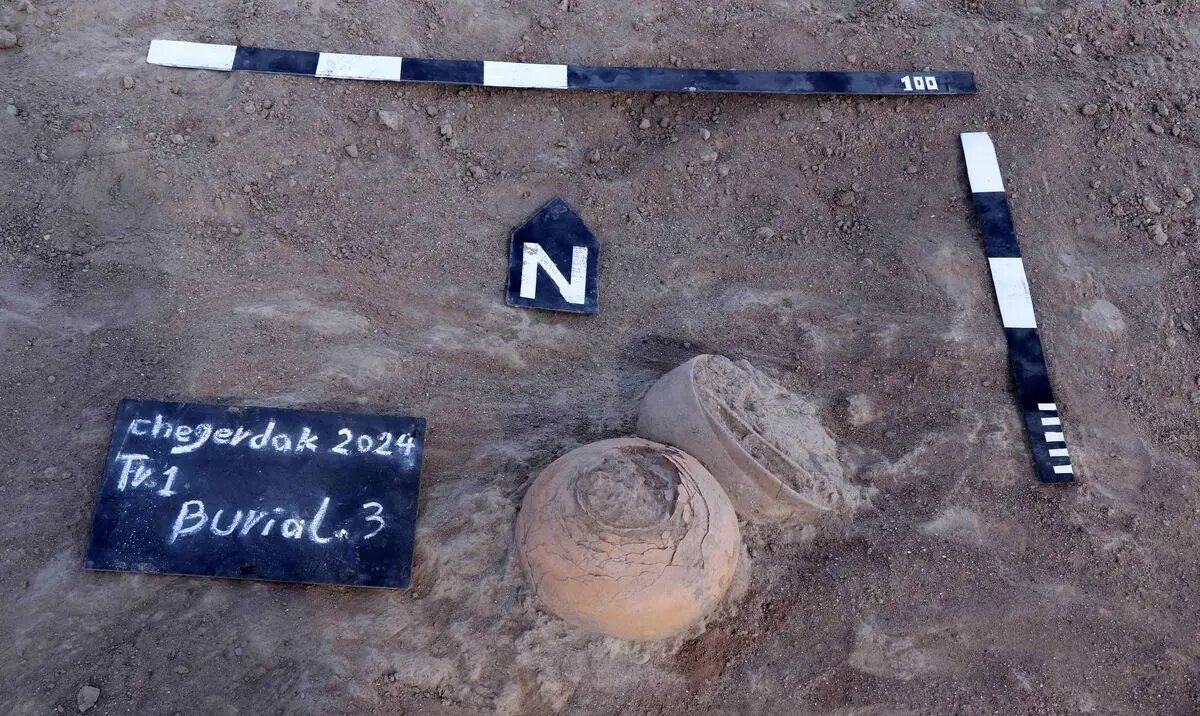Archaeologists to shed new light on Bronze Age site, southeast Iran

TEHRAN – A team of Iranian archaeologists has commenced salvage work and survey on Chegerdak, a Bronze Age site in southeast Iran.
Spearheaded by Mohammad Heidari and Morteza Gorgi, the excavation aims to unravel the mysteries of human life and prehistoric burial traditions from the late fourth millennium BC to the early second millennium BC.
As reported by ILNA, the first phase of exploration is focused on Graveyard B at the Chegerdak site, situated in the plains of Chah Hashem in Dehlagan county. Recognized as one of the most significant prehistoric settlement centers in Sistan-Baluchestan province.
According to Heidari, Chegerdak is located in southeastern Hamun Jazmurian, approximately 50 kilometers from Dehlagan and 350 kilometers from the provincial capital, Zahedan.
The site comprises a main hill, Graveyards A and B, and pottery kilns, indicating continuous habitation from the mid-fourth millennium BC to the early second millennium BC.
Heidari revealed that Chegerdak came into the archaeological spotlight in the early 2000s due to unauthorized excavations in the cultural region of Jazmurian. Since then, special teams dispatched by the provincial cultural heritage department have been actively involved in organizing and salvaging activities for about two decades, significantly reducing the rate of illegal excavations.
The ongoing phase of exploration at Graveyard B in Chegerdak focuses on rescue operations, documentation, and recording of the remaining sections of the burial ground. The team aims to gain insights into burial traditions from the late fourth millennium BC to the early second millennium BC, while also studying signs of specialization, complexity, and social stratification.
Morteza Gorgi, another supervisor of the archaeological team, highlighted the systematic examination of the Chegerdak area and the study of disturbed surface data from looted graves. The discoveries so far suggest that Chegerdak was a significant site in the production and trade of chlorite vessels during the third millennium BC.
Gorgi emphasized the extensive findings of pottery workshops surrounding the site, the discovery of half-worked tools and stones, and the presence of marble and chlorite mines in the region.
During the Bronze Age, the valley of the Bampur river to the southeast of the Jazmurian basin hosted thriving
The large site of Chegerdak in the southern foothills of the Jazmurian basin emerged as a major center in the third millennium BC, with ceramics and seals attesting to significant cultural connections.
Based on the information given below, compose a news story about an archaeological survey and salvage work currently being conducted to shed new light on human life and prehistorical burial traditions in the site of Chegerdak in the southern foothills of the Jazmurian basin, southeast Iran.
During the Bronze Age, the valley of the Bampur river to the southeast of the Jazmurian basin hosted thriving communities, maximizing their connecting role between central Iran to the west and Pakistan, India, and Afghanistan to the east, according to the book “The Archaeology of Iran From Palaeolithic to the Achaemenid Empire,” written by archaeologists Roger Matthews and Hassan Fazali Nashli.
Analysis of a sediment core from the Jazmurian basin indicates that a significant increase in rainfall in the early third millennium BC may have provided a favorable context for the socio-cultural developments of this region and beyond.
The collective province — Sistan in the north and Baluchestan in the south — accounts for one of the driest regions of Iran, with a slight increase in rainfall from east to west and an obvious rise in humidity in the coastal regions. In ancient times, the region was a crossword between the Indus Valley and the Babylonian civilizations.
The province possesses special significance because it is located in a strategic transit location, particularly Chabahar, which is the only ocean port in Iran and the best and easiest access route in the middle Asian countries to free waters. Moreover, it is home to several distinctive archaeological sites and natural attractions, including two UNESCO World Heritage sites, namely Shahr-e-Soukhteh (Burnt City) and Lut desert.
AM
Leave a Comment